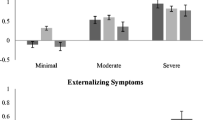Abstract
The present study examined Sluggish Cognitive Tempo (SCT) in relation to ADHD symptoms, clinical diagnosis, and multiple aspects of adjustment in a clinical sample. Parent and teacher reports were gathered for 322 children and adolescents evaluated for behavioral, emotional, and/or learning problems at a university clinic. Confirmatory factor analyses (CFA) supported the presence of three separate, but correlated factors (SCT, inattention, and hyperactivity/impulsivity) in both parent and teacher ratings. As expected, SCT symptoms were greatest in youth with ADHD Inattentive type, but were also found in non-ADHD clinical groups. SCT symptoms were related to inattention, internalizing, and social problems across both parent and teacher informants; for parent reports, SCT was also related to more externalizing problems. Findings support the statistical validity of the SCT construct, but its clinical utility is still unclear.
Similar content being viewed by others
References
Achenbach, T. (1991). Manual for the child behavior checklist/4–18 and 1991 Profile. Burlington: University of Vermont, Department of Psychiatry.
American Psychiatric Association. (2000). Diagnostic and statistical manual of mental disorders (4th ed.). Washington, DC: Author. text revision.
Bauermeister, J. J., Bird, H. R., Canino, G., Rubio-Stipec, M., Bravo, M., & Alegria, M. (1995). Dimensions of attention deficit hyperactivity disorder: findings from teacher and parent reports in a community sample. Journal of Clinical Child Psychology, 24, 264–271.
Bernstein, I. H., & Teng, G. (1989). Factoring items and factoring scales are different: Spurious evidence for multidimensionality due to item categorization. Psychological Bulletin, 105, 467–477.
Biderman, J., Newcorn, J., & Sprich, S. (1991). Comorbidity of attention deficit hyperactivity disorder with conduct, depressive, anxiety, and other disorders. The American Journal of Psychiatry, 148, 564–577.
Brito, G. N. O., Pinto, R. C. A., & Lins, M. F. C. (1995). A behavioral assessment scale for attention deficit disorder in Brazilian children based on DSM-III-R criteria. Journal of Abnormal Child Psychology, 23, 509–520.
Carlson, C. L., & Mann, M. (2002). Sluggish cognitive tempo predicts a different pattern of impairment in ADHD, predominantly inattentive type. Journal of Clinical Child and Adolescent Psychology, 31, 123–129.
Cohen, N. J., Vallance, D. D., Barwick, M., Im, N., Menna, R.,Horodezky, N. B., et al. (2000). The interface between ADHD and language impairment: An examination of language, achievement, and cognitive processing. Journal of Child Psychology and Psychiatry, 41, 353–362.
DuPaul, G. J., Power, T. P., Anastopoulos, A. D., & Reid, R. (1998). ADHD rating scale-IV. New York: Guilford.
Hartman, C. A., Willcutt, E. G., Rhee, S. H., & Pennington, B. F. (2004). The relation between sluggish cognitive tempo and DSM-IV ADHD. Journal of Abnormal Child Psychology, 32, 491–503.
Hoza, B., Mrug, S., Gerdes, A. C., Hinshaw, S. P., Bukowski, W. M., Gold, J. A., et al. (2005). What aspects of peer relationships are impaired in children with ADHD? Journal of Consulting and Clinical Psychology, 73, 411–423.
Kline, T. J. B. (2005). Psychological testing: A practical approach to design and evaluation (p. 35). Thousand Oaks: Sage.
Lahey, B. B., Pelham, W. E., Schaughency, E. A., Atkins, M. S., Murphy, H. A., Hynd, G. W., et al. (1988). Dimensions and types of attention deficit disorder with hyperactivity in children: a factor and cluster analytic approach. Journal of the American Academy of Child and Adolescent Psychiatry, 27, 330–335.
Lahey, B. B., Applegate, B., McBurnett, K., Biederman, J., Greenhill, L., Hynd, G. W., et al. (1994). DSM-IV field trials for attention deficit hyperactivity disorder in children and adolescents. The American Journal of Psychiatry, 151, 1673–1685.
McBurnett, K., Pfiffner, L. J., & Frick, P. J. (2001). Symptom properties as a function of ADHD type: an argument for continued study of sluggish cognitive tempo. Journal of Abnormal Child Psychology, 29, 207–213.
Milich, R., Loney, J., & Landu, S. (1982). The independent dimensions of hyperactivity and aggression: a validation with playroom observation data. Journal of Abnormal Psychology, 91, 183–189.
Milich, R., Balentine, A. C., & Lynam, D. R. (2001). ADHD combined type and ADHD predominantly inattentive type are distinct and unrelated disorders. Clinical Psychology: Science and Practice, 8, 463–488.
Muthén, L. K., & Muthén, B. O. (1998–2006). Mplus version 4.2 [Computer program]. Los Angeles: Muthén & Muthén.
Muthén, B., du Toit, S. H. C., & Spisic, D. (1997). Robust inference using weighted least squares and quadratic estimating equations in latent variable modeling with categorical and continuous outcomes. Los Angeles: University of California, Unpublished manuscript.
Panter, A. T., Swygert, K. A., Dahlstrom, W. G., & Tanaka, J. S. (1997). Factor analytic approaches to personality item-level data. Journal of Personality Assessment, 68, 561–589.
Penny, A. M., Waschbusch, D. A., Klein, R. M., Corkum, P., & Eskes, G. (2009). Developing a measure of sluggish cognitive tempo for children: content validity, factor structure, and reliability. Psychological Assessment, 21, 380–389.
Reeves, C., Palmer, S., Gross, A., Simonian, S., Taylor, L., Willingham, E., et al. (2007). Brief report: sluggish cognitive tempo among pediatric survivors of acute lymphoblastic leukemia. Journal of Pediatric Psychology, 32(9), 1050–1054.
Todd, R. D., Rasmussen, E. R., Wood, C., Levy, F., & Hay, D. A. (2004). Should sluggish cognitive tempo symptoms be included in the diagnosis of attention-deficit/hyperactivity disorder? Journal of the American Academy of Child and Adolescent Psychiatry, 43(5), 491–503.
Author information
Authors and Affiliations
Corresponding author
Rights and permissions
About this article
Cite this article
Garner, A.A., Marceaux, J.C., Mrug, S. et al. Dimensions and Correlates of Attention Deficit/Hyperactivity Disorder and Sluggish Cognitive Tempo. J Abnorm Child Psychol 38, 1097–1107 (2010). https://doi.org/10.1007/s10802-010-9436-8
Published:
Issue Date:
DOI: https://doi.org/10.1007/s10802-010-9436-8




